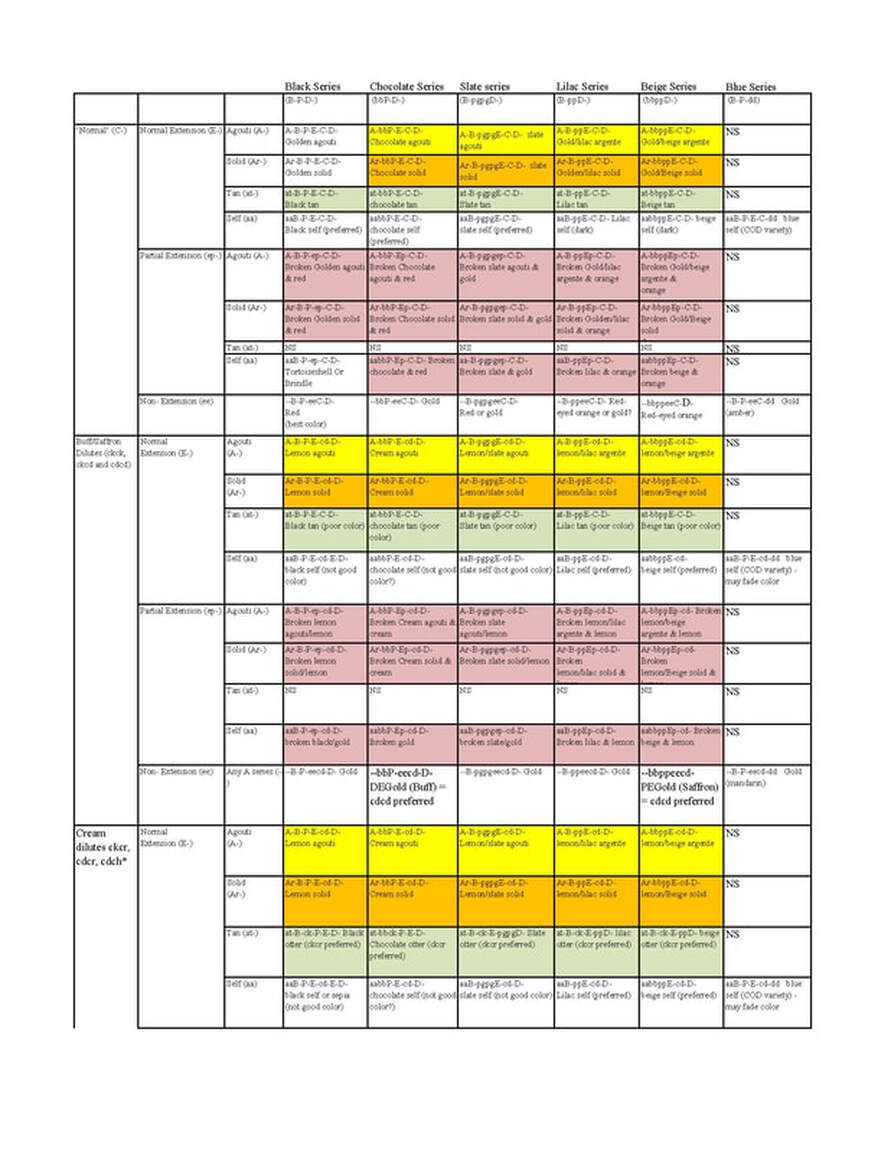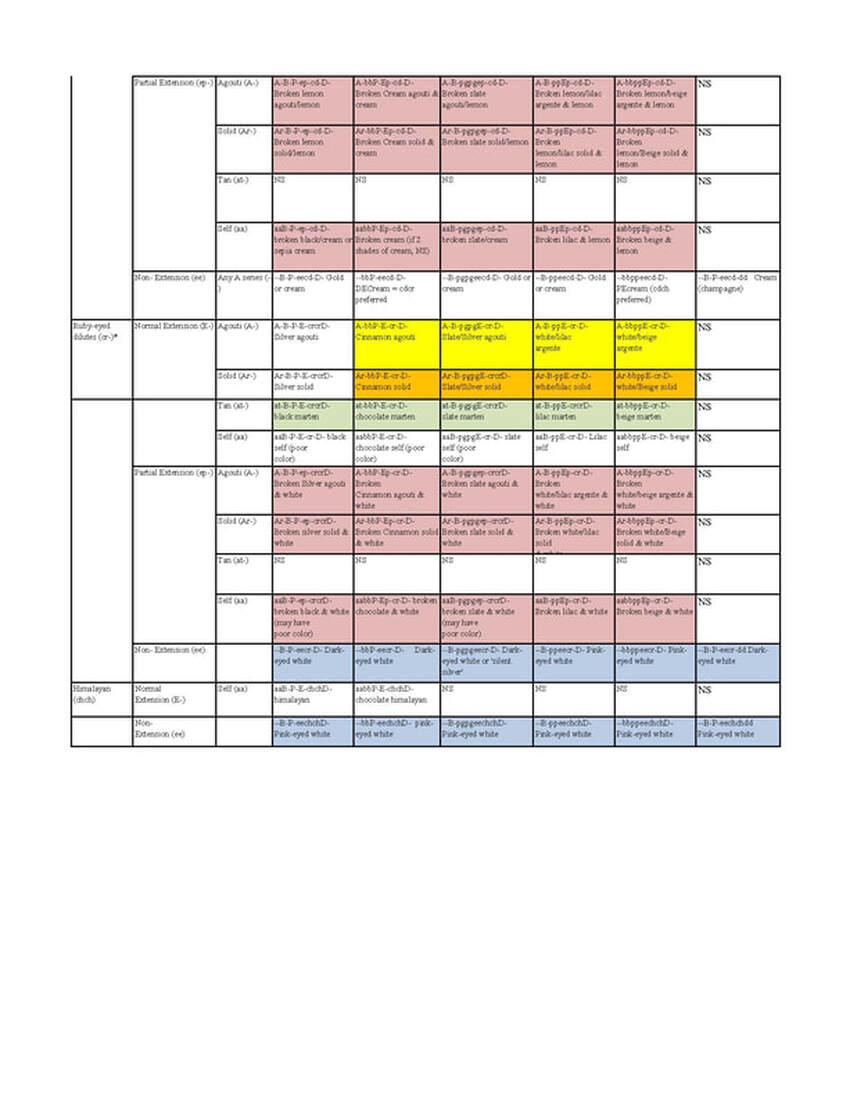Cavy Genetics Chart
Everything about the 5 Basic Cavy Color Genes (A, B, C, P, E) in one handy chart...color names matched to the ACBA standard.
* sepia (cdch + E-) and sable (crch + E-) variants have a faded body color combined with darker points which is a major fault (typically disqualification) under ACBA rules.
NS = non-showable (under ACBA standard)
Yellow are shown as 'dilute agouti' under ACBA standard.
Orange are shown as 'dilute solid' under ACBA standard
Green are shown as 'tan pattern group' under ACBA standard
Pink are shown as part of the broken group under ACBA standard.
Blue are shown as white (including both dark eyes and pink eyed white) under ACBA standard. Ears must be free of pigment (pink only) to show as white. Some genotypes included here for DEW may give animals with darker ears which are not showable.
NS = non-showable (under ACBA standard)
Yellow are shown as 'dilute agouti' under ACBA standard.
Orange are shown as 'dilute solid' under ACBA standard
Green are shown as 'tan pattern group' under ACBA standard
Pink are shown as part of the broken group under ACBA standard.
Blue are shown as white (including both dark eyes and pink eyed white) under ACBA standard. Ears must be free of pigment (pink only) to show as white. Some genotypes included here for DEW may give animals with darker ears which are not showable.
- Entries in the chart for the 'red series' are collapsed with -- indicating any A gene (A-, Ar-, At-, aa) as the effect of the A gene is largely hidden by the ee genotype. The red series is subdivided into Red, Orange, Gold, Cream and White based on eye color and color intensity. Degree of intensity can be substantially altered from the above 'baseline genotype indicators' by the action of rufus factor modifiers (for example, a red with poor rufus factor may be so light as to be considered a gold).
- Chocolate himalayan can be shown in the himalayan group (ACBA standard), however, preference is given to the darker point color more typical of the black.
- Broken is a large group consisting of animals with patches in 2 or 3 colors. These can be any of the two-color combinations of the accepted colors (highlighted in pink above), any single accepted color above with white (added via the white-spotting gene S), or any two-color combination above (pink) plus white (two colors plus white to give three colors - white again added by the S gene). Agouti, solid and self are all acceptable in brokens - tan pattern is not. Tortoiseshell (black and white patches) and tortoiseshell & white are judged separately from each other and from the rest of the brokens. Brindle have the same base genotype as tortoiseshell but preference for even intermixing of the hairs. Dutch (a small subset of the allowable single colors plus white added via the S gene with modifiers to achieve the correct pattern) are also shown separately. All other brokens are shown as a single group. The ideal alternating harlequin pattern of the broken is more easily achieved with the Ep gene than with the white spotting gene (S). Tri-colors have both the Ep and white-spotting genes.
- Roan and dalmatian are not included in the above chart. These are achieved by the addition of the Rnrn genotype.
-- Roans are shown as a single group under the ACBA standard -- roan plus one or two accepted color(s) in the above chart (bicolor + roan is accepted, as are agouti and solid pattern roans) except for white (which would not show the roaning). Roans with the white-spotting gene may be shown in the broken group (not the roan group) but are not preferred as the roaning 'blurs' the patch edges (and broken may hide roan creating potential for hidden roan and accidental lethal white).
--Dalmatian is a derivative of the roan genotypes in which modifiers cause the colored hairs to cluster in spots. Dalmatian are allowed in any single of the SELF colors (black, chocolate, slate, lilac, beige, red, orange, gold, cream). White, Bicolors, agouti, solid and tan patterns are not allowed.
NOTE: the RnRn genotype results in 'lethal white' pups with usually severe deformities of the eyes and teeth. For this reason, roans & dalmatians should be bred to non-white animals - never to each other.
- Californian - Kk can be added to any of the ee genotypes (red, orange, gold, cream or white body color) with any of the approved base colors (currently not including blue) and shown as californians -- eye colors must correspond to the point color (e.g., pink eyes and black/chocolate points would be himalayan). Note that KK creates darker 'sooty' markings that are heavily faulted. Good californians do not breed true - always producing some offspring of the kk type without points (which can be shown as red, orange, gold, cream, white) and some of the KK type. KK type can be bred to the unmarked kk to produce correctly colored offspring. NOTE: californians are born without markings, these develop over the 1st ~ 8 weeks of life.
- Chocolate himalayan can be shown in the himalayan group (ACBA standard), however, preference is given to the darker point color more typical of the black.
- Broken is a large group consisting of animals with patches in 2 or 3 colors. These can be any of the two-color combinations of the accepted colors (highlighted in pink above), any single accepted color above with white (added via the white-spotting gene S), or any two-color combination above (pink) plus white (two colors plus white to give three colors - white again added by the S gene). Agouti, solid and self are all acceptable in brokens - tan pattern is not. Tortoiseshell (black and white patches) and tortoiseshell & white are judged separately from each other and from the rest of the brokens. Brindle have the same base genotype as tortoiseshell but preference for even intermixing of the hairs. Dutch (a small subset of the allowable single colors plus white added via the S gene with modifiers to achieve the correct pattern) are also shown separately. All other brokens are shown as a single group. The ideal alternating harlequin pattern of the broken is more easily achieved with the Ep gene than with the white spotting gene (S). Tri-colors have both the Ep and white-spotting genes.
- Roan and dalmatian are not included in the above chart. These are achieved by the addition of the Rnrn genotype.
-- Roans are shown as a single group under the ACBA standard -- roan plus one or two accepted color(s) in the above chart (bicolor + roan is accepted, as are agouti and solid pattern roans) except for white (which would not show the roaning). Roans with the white-spotting gene may be shown in the broken group (not the roan group) but are not preferred as the roaning 'blurs' the patch edges (and broken may hide roan creating potential for hidden roan and accidental lethal white).
--Dalmatian is a derivative of the roan genotypes in which modifiers cause the colored hairs to cluster in spots. Dalmatian are allowed in any single of the SELF colors (black, chocolate, slate, lilac, beige, red, orange, gold, cream). White, Bicolors, agouti, solid and tan patterns are not allowed.
NOTE: the RnRn genotype results in 'lethal white' pups with usually severe deformities of the eyes and teeth. For this reason, roans & dalmatians should be bred to non-white animals - never to each other.
- Californian - Kk can be added to any of the ee genotypes (red, orange, gold, cream or white body color) with any of the approved base colors (currently not including blue) and shown as californians -- eye colors must correspond to the point color (e.g., pink eyes and black/chocolate points would be himalayan). Note that KK creates darker 'sooty' markings that are heavily faulted. Good californians do not breed true - always producing some offspring of the kk type without points (which can be shown as red, orange, gold, cream, white) and some of the KK type. KK type can be bred to the unmarked kk to produce correctly colored offspring. NOTE: californians are born without markings, these develop over the 1st ~ 8 weeks of life.


